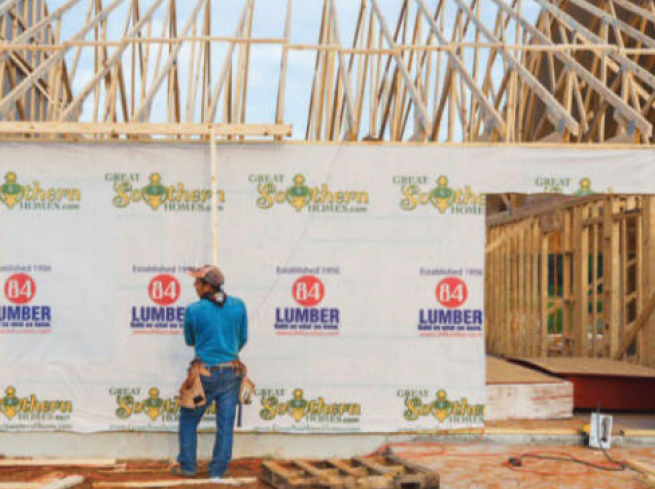Long-standing factors are also contributing to the construction labour shortages.
長期存在的一些因素也導(dǎo)致了建筑工人短缺。
Homebuilders have struggled to maintain a consistent labour force since the global financial crisis of 2007-09.
自2007年至2009年的全球金融危機(jī)以來,住房建筑商一直難以維持穩(wěn)定的勞動力隊(duì)伍。
That in part reflects deeper changes to immigration laws, which have stemmed a once-steady stream of labour.
這在一定程度上反映了移民法的深層次變化,這些變化妨礙了一度穩(wěn)定的勞動力流動。
Inflows of foreign workers into America, for instance, have been in decline since the introduction of anti-immigration policies by President Donald Trump.
例如,自唐納德·特朗普總統(tǒng)推出反移民政策以來,流入美國的外國工人數(shù)量一直在下降。

Just over 44,000 foreign-born workers entered the construction industry in 2017, a sharp drop compared with nearer 70,000 in the previous year.
2017年,有4.4萬多名外國出生的工人進(jìn)入建筑行業(yè),與前一年近7萬名相比大幅下降。
Similarly, the Office for National Statistics reckons that Britain has lost 42% of its European construction workers since its vote to leave the European Union, which signalled an end to the free movement of migrants from the EU into the country.
同樣,英國國家統(tǒng)計(jì)局估計(jì),自公投脫歐以來,英國流失了42%的歐洲建筑工人,脫歐意味著歐盟移民無法再自由進(jìn)入英國。
Skills shortages are also compounded by an ageing workforce.
勞動力老齡化也加劇了技能短缺。
Around 41% of construction workers in America are expected to retire within the next decade.
美國約41%的建筑工人預(yù)計(jì)將在未來10年內(nèi)退休。
One in five British workers is over the age of 55.
五分之一的英國工人年齡在55歲以上。
Recruiters seeking talent, meanwhile, find slim pickings.
與此同時(shí),尋找人才的招聘人員發(fā)現(xiàn),他們的選擇余地很小。
High-school graduates of all income backgrounds avoid construction jobs, perceiving them to be dirty, dangerous and difficult.
所有收入背景的高中畢業(yè)生都不愿從事建筑工作,他們認(rèn)為這些工作骯臟、危險(xiǎn),還很難。
Less than one in ten young people in Britain would consider a career in construction, shunning even white-collar jobs in areas such as engineering, quantity surveying and town planning.
在英國,只有不到十分之一的年輕人會考慮從事建筑行業(yè),甚至連工程、工料測量和城市規(guī)劃等白領(lǐng)工作都不愿做。
Automation might have been one way to avert shortages of workers.
自動化可能是解決工人短缺的方法之一。
But the industry has been slow to embrace it.
但該行業(yè)對自動化的接受速度比較緩慢。
Around half of construction businesses use robots, compared with 84% of automotive firms and 79% of manufacturing companies.
約有一半的建筑企業(yè)使用了機(jī)器人,相比之下,有高達(dá)84%的汽車企業(yè)和79%的制造企業(yè)在使用機(jī)器人。
Meanwhile, the shortages seem set only to intensify.
與此同時(shí),工人供應(yīng)短缺似乎只會加劇。
Demand for workers looks likely to rise further, as governments promise both to build more houses and to help prepare the existing stock for a changing climate.
目前,政府承諾建造更多房屋,并幫助現(xiàn)有房屋為氣候變化做好準(zhǔn)備,建筑業(yè)對工人的需求可能會進(jìn)一步上升。
Britain already requires 217,000 extra workers by 2025 to meet the government’s target of 300,000 new homes per year.
英國已經(jīng)要求在2025年前增加21.7萬名工人,以達(dá)到政府每年新建30萬套住房的目標(biāo)。
Even more labour will be needed to retrofit 29m existing homes to meet net-zero carbon targets by 2050.
為了在2050年實(shí)現(xiàn)凈零碳目標(biāo),還需要更多的勞動力來改造2900萬套現(xiàn)有房屋。
Governments’ plans to spend on infrastructure in America and Europe could suck in workers and leave fewer to build houses.
美國和歐洲政府的基礎(chǔ)設(shè)施投資計(jì)劃可能會吸引工人,導(dǎo)致更少的人愿意留下來去建造房屋。
Job vacancies, construction delays, bosses’ headaches—all may go through the roof.
職位空缺、施工延誤、老板們的頭痛——所有這些都可能沖破頂峰。
譯文由可可原創(chuàng),僅供學(xué)習(xí)交流使用,未經(jīng)許可請勿轉(zhuǎn)載。











